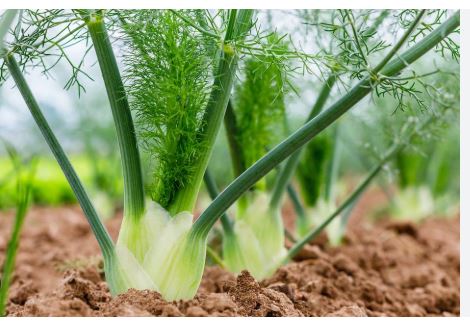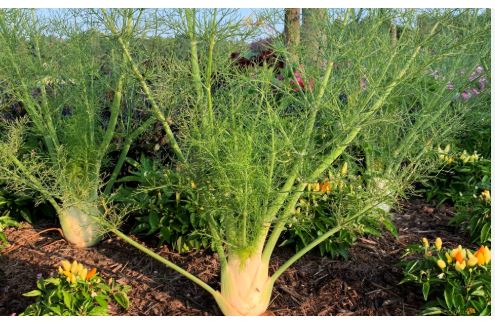
Fennel (Foeniculum vulgare) is a perennial herbaceous plant in the Apiaceae family, also known as the carrot or parsley family, which includes relatives like carrots (Daucus carota), celery (Apium graveolens), and dill (Anethum graveolens). Classified under the genus Foeniculum, its primary edible species is F. vulgare, with two main varieties: F. vulgare var. vulgare (wild or bitter fennel) and F. vulgare var. azoricum (Florence fennel, grown for its bulb). As a dicot, it features feathery leaves and umbel-shaped flower clusters typical of the family.
Fennel is native to the Mediterranean region, particularly southern Europe and North Africa, where it thrives in dry, rocky soils near the coast. Its wild form likely originated in what is now Italy, Greece, or Turkey, favoring limestone-rich environments. Archaeological evidence points to its presence in the Mediterranean basin for millennia, with domestication refining the bulbous Florence variety for cultivation.
Fennel’s use dates back to antiquity—ancient Egyptians, Greeks, and Romans prized it for food, medicine, and ritual. Pliny the Elder documented its virtues in the 1st century CE, while Greek mythology linked it to Prometheus stealing fire in a fennel stalk. By the Middle Ages, it spread across Europe, valued for digestion and warding off evil spirits. Introduced to the Americas and Asia via colonial trade, Florence fennel became a culinary star in Italy, while seeds dominated spice use elsewhere.
Fennel is unmistakable: Florence fennel has a swollen, white bulb (2-4 inches wide) at the base, tapering into thick, green stalks topped with feathery, fern-like leaves. Wild fennel lacks the bulb, growing taller (up to 6 feet) with slender stems. Both bear yellow, umbrella-like flower clusters in summer, producing small, ridged, grayish-green seeds (3-5 mm long). Its anise-like aroma—due to anethole—permeates all parts, from bulb to seeds.
Fennel prefers cool weather, with peak seasons in fall and spring (September-November and March-May) in temperate regions like the U.S. and Europe. In Mediterranean climates, it’s harvested year-round, especially Florence fennel, which matures 90-120 days after planting. Seeds are collected in late summer from wild or spice-focused plants. Fresh fennel is widely available in markets, while seeds are a year-round pantry staple.
Fennel’s versatility shines across its parts: the bulb is sliced raw into salads for a crisp, licorice-like crunch, roasted for caramelized sweetness, or braised in soups and stews. Stalks add flavor to broths, while feathery fronds garnish fish or salads. Seeds—whole or ground—spice sausages, breads (e.g., Italian taralli), and Indian curries, or steep into teas. In Mediterranean cuisine, it pairs with seafood; globally, it’s a digestif or palate cleanser.
Fennel is low-calorie (31 kcal per 100 g bulb) yet nutrient-dense, offering vitamin C (12 mg, 14% DV) for immunity, potassium (414 mg, 9% DV) for heart health, and fiber (3.1 g, 11% DV) for digestion. It’s rich in antioxidants like quercetin and anethole, linked to anti-inflammatory and antimicrobial benefits. Seeds provide concentrated oils, aiding bloating relief, while the bulb adds folate and manganese. Its hydrating 90% water content enhances its lightness.

Culivation of Fennel
Climate Requirements
Fennel thrives in cool to mild climates, with optimal temperatures of 60-70°F (15-21°C) for bulb development in Florence fennel. It tolerates light frost but struggles above 80°F (27°C), where bolting (premature flowering) can occur. Seed-focused wild fennel adapts to warmer, drier conditions, making it more resilient in Mediterranean-like summers.
Soil Preferences
Well-drained, fertile soil with a pH of 6.0-7.0 suits fennel best. Florence fennel prefers loamy or sandy loam enriched with organic matter (compost or manure) for bulb growth, while wild fennel tolerates poorer, rocky soils. Good drainage is critical—waterlogged roots stunt bulbs or rot plants.
Site Selection
Choose a sunny spot with 6-8 hours of direct light daily, as fennel demands full sun for robust growth and flavor. Shelter from strong winds protects its tall, feathery stalks. In hot climates, slight afternoon shade can prevent heat stress, especially for bulb varieties.
Propagation Methods
Fennel is grown from seeds, sown directly or started indoors. Florence fennel seeds are planted ¼ inch deep; wild fennel scatters more freely. Germination takes 7-14 days at 60-70°F (15-21°C). Transplants work for bulbs but require care to avoid root disturbance, as fennel resents disruption.
Planting Time
Sow Florence fennel in early spring (March-April) or late summer (July-August) for fall harvests in temperate zones, avoiding summer heat. Wild fennel can be planted year-round in mild climates, with spring or fall ideal for seed production. Aim for soil temperatures above 50°F (10°C) to kickstart growth.
Watering Needs
Keep soil consistently moist but not soggy—1 inch (2.5 cm) of water weekly, adjusted for rainfall. Florence fennel needs steady moisture for tender bulbs; underwatering toughens them. Wild fennel is more drought-tolerant once established but benefits from occasional deep watering during dry spells.
Fertilization
Apply a balanced fertilizer (e.g., 10-10-10 NPK) at planting, then side-dress with nitrogen (e.g., 21-0-0) every 4-6 weeks for leafy growth. Florence fennel benefits from extra phosphorus and potassium for bulb size. Avoid over-fertilizing—excess nitrogen triggers bolting and reduces bulb quality.
Spacing and Support
Space Florence fennel 12-18 inches apart in rows 18-24 inches wide to allow bulb expansion; wild fennel can be 18-24 inches apart for seed crops. Taller varieties (up to 6 feet) may need staking in windy areas, though most stand upright naturally. Thin seedlings to prevent crowding.
Blanching (for Florence Fennel)
To sweeten and whiten Florence fennel bulbs, mound soil or mulch around the base 2-3 weeks before harvest, covering up to half the bulb. This blanching reduces bitterness and greenness from sunlight exposure. Wild fennel skips this step, as bulbs aren’t the focus.
Pest and Disease Management
Aphids, slugs, and parsley worms (swallowtail caterpillars) target fennel—use insecticidal soap or hand-pick pests. Root rot (from poor drainage) and powdery mildew (humid conditions) are risks; ensure good airflow and dry foliage. Fennel’s strong scent deters some pests, but crop rotation prevents soil-borne issues.
Growth Cycle
Florence fennel matures in 90-120 days from sowing, with bulbs ready when 3-4 inches wide. Wild fennel takes 100-150 days to flower and set seed, often grown as a perennial in mild climates. Bolting is a risk in heat or drought—harvest bulbs early if flowering starts.
Harvesting
Cut Florence fennel bulbs at soil level when firm and plump, leaving roots to regrow in mild climates. For seeds, wait until wild fennel’s umbels turn brown (late summer), then clip and dry heads upside-down in bags to catch seeds. Leaves can be snipped anytime for fresh use.
Post-Harvest Care
Store fresh Florence fennel bulbs in a refrigerator at 32-36°F (0-2°C) in a damp cloth for 2-4 weeks; seeds keep in airtight containers for years. Post-harvest, clear debris and refresh soil for perennials or next planting. In frost-free zones, fennel regrows from roots for multiple seasons.